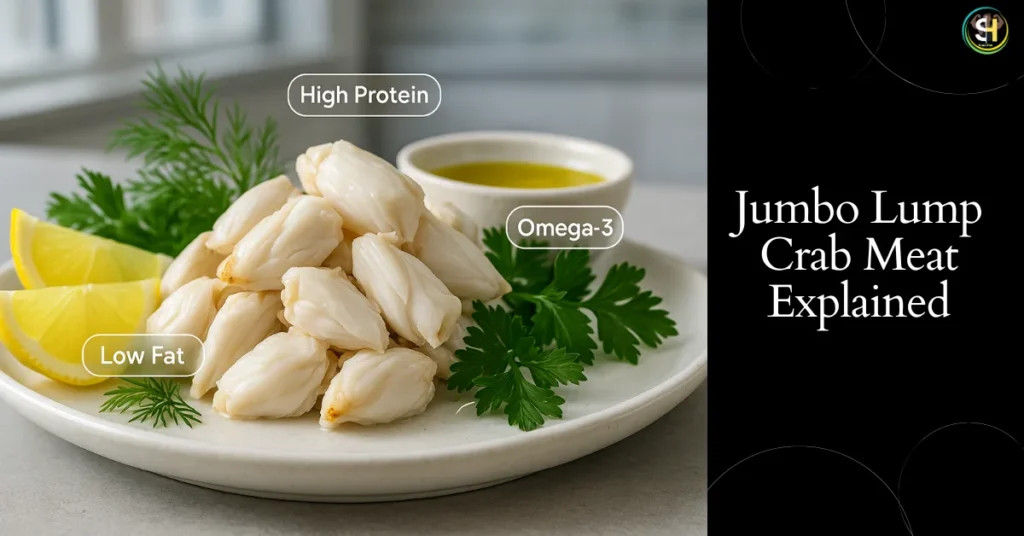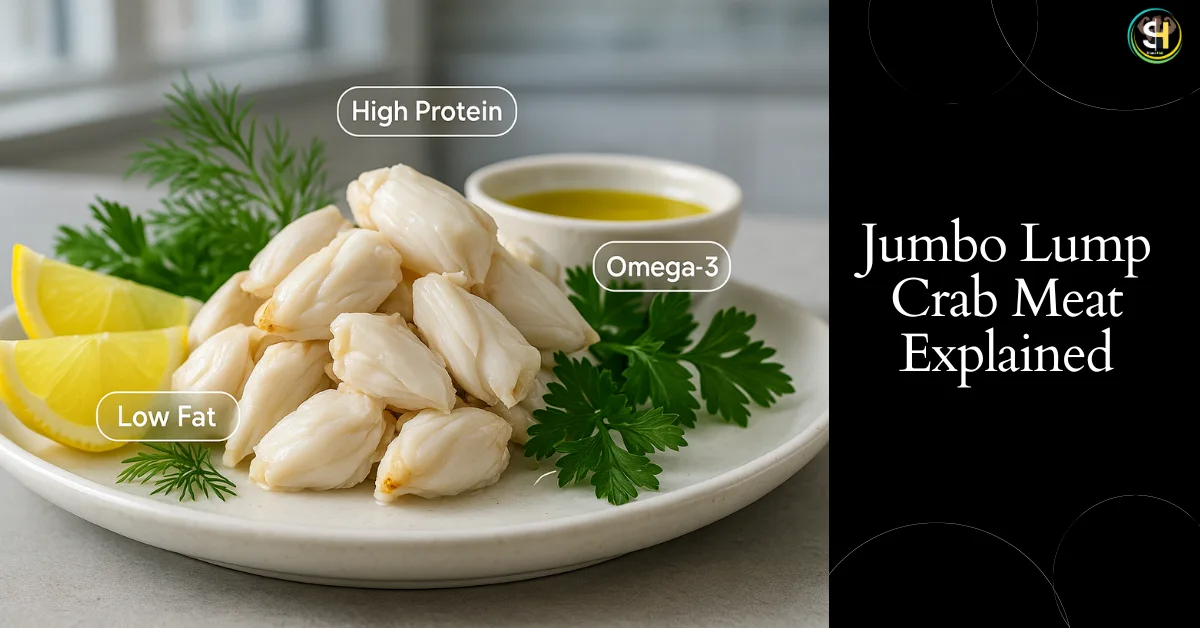
Jumbo lump crab meat is a true seafood delicacy, revered for its succulent texture, delicate flavor, and premium quality. From elegant crab cakes to upscale pasta dishes, jumbo lump crab meat adds gourmet flair and nutritional value to a variety of meals. But is this luxury ingredient actually good for your health, and how do you ensure you’re buying the best?
What Is Jumbo Lump Crab Meat?
Jumbo lump crab meat comes from the swimmer muscles of blue crabs (Callinectes sapidus), particularly from the large muscles connected to the crab’s back legs. These chunks are prized for being:
- Large and whole
- White and flaky
- Sweet and delicate in flavor
- Minimal in shell fragments
Among the five main grades of crab meat—jumbo lump, lump, backfin, special, and claw meat—jumbo lump is the most premium and expensive due to its limited yield and superior quality.
Jumbo Lump Crab Meat Nutrition Facts
Per 3 oz (85g) serving of cooked jumbo lump blue crab meat:
| Nutrient | Amount |
| Calories | 80 |
| Protein | 17 grams |
| Total Fat | 1.5 grams |
| Saturated Fat | 0 grams |
| Carbohydrates | 0 grams |
| Omega-3 Fatty Acids | 300–500 mg |
| Cholesterol | 45 mg |
| Sodium | 240 mg |
| Vitamin B12 | 9 mcg (375% DV) |
| Selenium | 40 mcg (70% DV) |
| Zinc | 3.5 mg (32% DV) |
| Copper | 0.6 mg (67% DV) |
Key Takeaway:
Jumbo lump crab meat is low in calories and fat yet rich in high-quality protein, B vitamins, and essential minerals — a powerhouse for health-focused consumers.
Health Benefits of Jumbo Lump Crab Meat
1. High-Quality Lean Protein
Crab meat delivers complete protein with all 9 essential amino acids, making it ideal for:
- Muscle repair and growth
- Satiety and appetite control
- Supporting immune function
Unlike red meat, it contains very little saturated fat, making it heart-friendly.
2. Rich in Omega-3 Fatty Acids
Although not as high in omega-3s as salmon, crab still provides EPA and DHA, essential for:
- Brain function and mental clarity
- Reducing inflammation
- Lowering risk of heart disease
Omega-3s also play a role in eye health and joint mobility.
3. Loaded with Vitamin B12
One serving of jumbo lump crab meat gives over 300% of the Daily Value for vitamin B12 — a nutrient critical for:
- Red blood cell formation
- DNA synthesis
- Nervous system health
- Energy production
Vitamin B12 is especially crucial for vegetarians and older adults, who may be deficient.
4. Supports Thyroid and Immune Function
Crab meat is high in selenium and zinc, two trace minerals that:
- Support thyroid hormone production
- Boost immune response
- Act as antioxidants to combat cellular damage
These minerals also help maintain reproductive health and wound healing.
5. Low in Mercury (Compared to Other Seafood)
Blue crab is categorized as a “low mercury” seafood by the FDA, making it safer for:
- Pregnant women
- Children
- Frequent seafood consumers
However, moderation is still key.
Is Jumbo Lump Crab Meat Sustainable?
Sustainability is a concern when it comes to seafood. Fortunately, blue crab populations, especially in the Chesapeake Bay and Gulf Coast, are closely managed and regulated.
Look for products certified by:
- Marine Stewardship Council (MSC)
- Best Aquaculture Practices (BAP)
- Seafood Watch (Monterey Bay Aquarium)
These ensure you’re buying crab meat that is:
- Responsibly sourced
- Harvested with minimal bycatch
- Not contributing to overfishing
Fresh vs. Canned Jumbo Lump Crab Meat
| Feature | Fresh | Canned/Pasteurized |
| Flavor | Superior, sweet, fresh ocean taste | Slightly muted due to pasteurization |
| Texture | Firm and flaky | Softer, sometimes broken |
| Shelf Life | 1–2 days (refrigerated) | 6–12 months (unopened) |
| Availability | Seasonal/regional | Year-round |
| Price | More expensive | Slightly more affordable |
Expert Tip:
For recipes like crab cakes or dips, canned jumbo lump crab meat works well. For salads or seafood towers, opt for fresh to preserve texture and taste.
Buyer Tips: How to Choose High-Quality Jumbo Lump Crab Meat
✅ 1. Check the Label for Country of Origin
Always verify where the crab meat is sourced from. U.S. origin (like Maryland or Gulf Coast) is often higher quality and more tightly regulated.
✅ 2. Look for Certification Logos
Choose brands with labels such as MSC Certified or Sustainable Seafood Certified.
✅ 3. Inspect the Appearance
Premium jumbo lump crab meat should be:
- Bright white
- Firm and intact
- Free of shell fragments or discoloration
✅ 4. Smell the Product
It should smell clean, like the ocean — never fishy or sour. A strong odor is a red flag for spoilage.
✅ 5. Check Expiration Date (for Canned)
Pasteurized crab meat should be refrigerated and consumed by the ‘use by’ date. Once opened, use within 2–3 days.
Best Ways to Enjoy Jumbo Lump Crab Meat
Jumbo lump crab is versatile and can be used in a wide variety of dishes:
🦀 Popular Recipe Ideas:
- Classic Maryland Crab Cakes – Minimal filler, lots of jumbo lump
- Chilled Crab Salad – With citrus vinaigrette and arugula
- Seafood Pasta – Tossed with lemon, olive oil, and garlic
- Stuffed Mushrooms or Avocados – Elegant appetizers
- Crab Benedict – A brunch favorite with poached eggs and hollandaise
Cooking Tip:
Avoid over-mixing or overcooking — it breaks down the delicate chunks. Add crab meat last when incorporating into hot dishes.
Is Jumbo Lump Crab Meat Safe During Pregnancy?
Yes, in moderation. Blue crab has low mercury levels, making it one of the safer seafood options during pregnancy.
Benefits for Pregnant Women:
- Omega-3s support fetal brain development.
- Vitamin B12 and iron help with energy and prevent anemia.
Safe Intake:
The FDA recommends up to 2–3 servings (8–12 oz) per week of low-mercury seafood, including blue crab.
Jumbo Lump Crab Meat vs Other Crab Grades
| Grade | Description | Best Use |
| Jumbo Lump | Large, whole muscle chunks | Salads, elegant dishes, seafood towers |
| Lump | Smaller broken pieces of jumbo lump | Crab cakes, pasta |
| Backfin | Blend of lump and flakes | Crab dip, soups |
| Special | Smaller white flakes | Casseroles, crab stuffing |
| Claw Meat | Darker, more flavorful | Soups, sauces |
Common Myths About Jumbo Lump Crab Meat
❌ Myth #1: All crab meat is the same.
Fact: Jumbo lump is a premium cut with better texture and flavor than other grades.
❌ Myth #2: Crab meat is too high in cholesterol.
Fact: Though crab contains cholesterol, it’s low in saturated fat and contains heart-protective omega-3s.
❌ Myth #3: Canned crab is always low quality.
Fact: Many canned jumbo lump options are pasteurized at peak freshness and retain excellent quality when handled properly.
Final Verdict: Is Jumbo Lump Crab Meat Worth It?
✅ Nutritionally: Yes
Jumbo lump crab meat is a lean, complete protein source rich in vitamins, minerals, and omega-3 fatty acids.
✅ Culinary Value: Yes
Its sweet flavor and firm texture make it a culinary star, perfect for high-end recipes or special occasions.
✅ Sustainability: Conditional
Choose certified sustainable brands to support ocean health and ethical practices.
Frequently Asked Questions (FAQs)
❓ Is jumbo lump crab meat healthy?
Yes. It’s a nutrient-dense food rich in protein, B12, selenium, and omega-3s with minimal fat.
❓ Can I eat crab meat on a keto or low-carb diet?
Absolutely. Crab meat contains 0 grams of carbs, making it perfect for keto, paleo, or diabetic diets.
❓ Is jumbo lump crab meat better than imitation crab?
Yes. Imitation crab (surimi) is processed and often contains fillers and additives, while jumbo lump is real, whole crab meat.
❓ How do I store opened canned crab meat?
Keep it in an airtight container and consume within 2–3 days, stored at or below 40°F (4°C).
